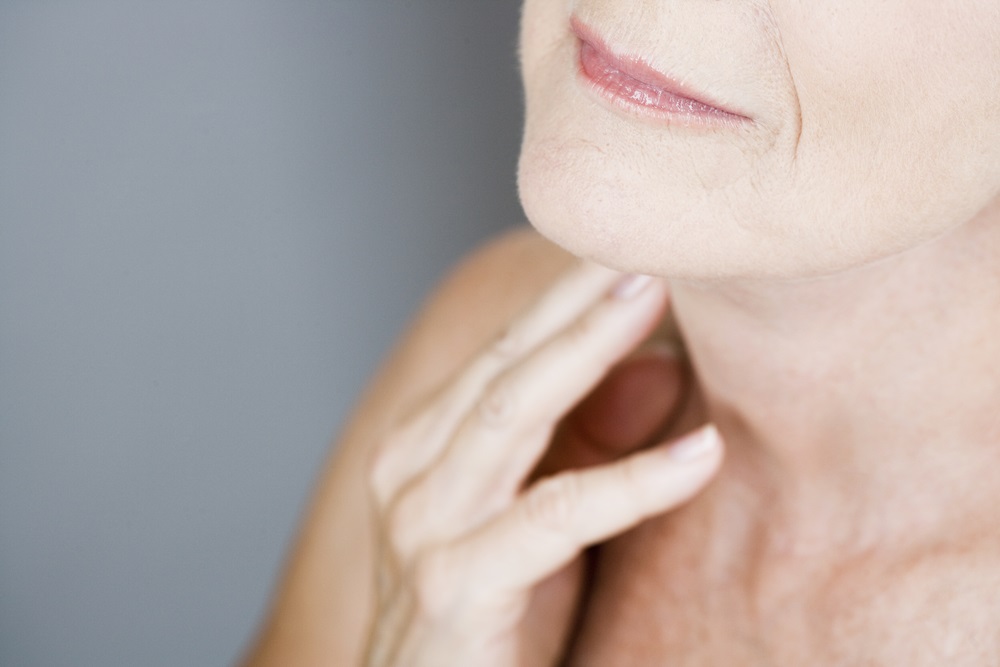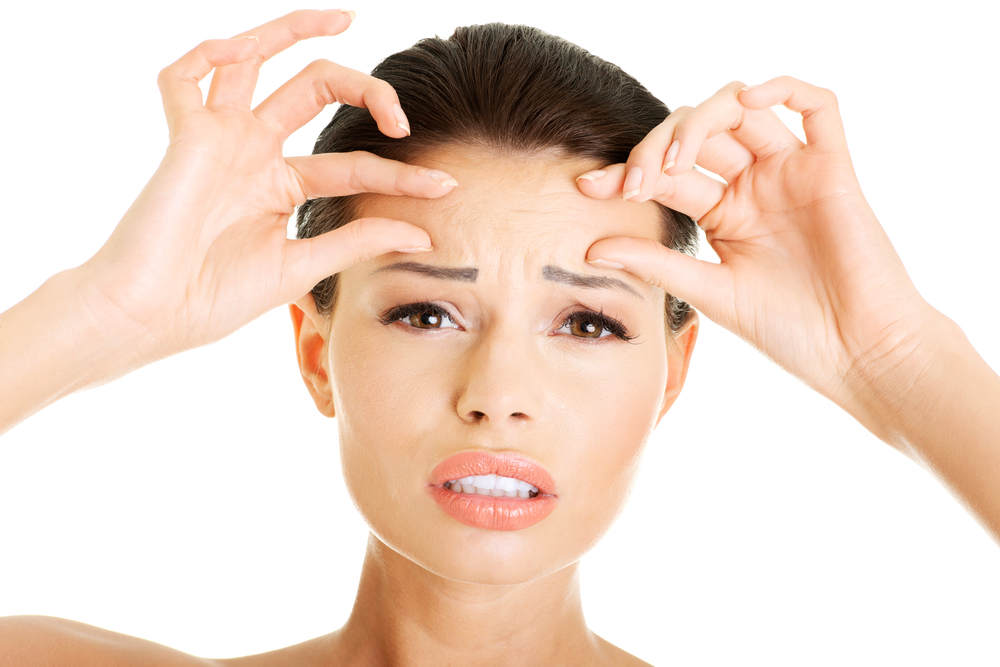- Jowls can be reduced through surgical or non-surgical interventions.
- So-called anti-aging facial exercises are ineffective, and may actually make jowls worse.
- Regular use of skin care products can help to repair and maintain the skin’s tone and texture.
What are jowls?
Jowls are the areas of skin and tissue on your face that sag below your chin or jawline. They appear on almost everyone as they age, and become increasingly visible as time goes by.
Genetic predisposition is one known factor for pronounced jowls. Oftentimes, you can look at your older family members to get a sense of how jowls will affect your appearance as you age. Jowls can also be exacerbated by weight loss and exposure to the sun.
If you’re tired of the way your jowls make you look, it might seem like invasive procedures are the only way to tighten all that loose, hanging skin. Luckily, there are several other options that can give the area below your chin more definition and tone.
With the advances in dermal fillers and energy-based procedures, there are plenty of no-knife options available — you just need to pick the one that’s best for you.
Depending on the condition of the skin around your jaw area, certain procedures may be more effective than others, so be sure to seek out expert medical advice before undergoing any sort of treatment.
Surgical procedures
Mini facelifts concentrate on wrinkles and signs of aging in the lower third of the face. If you’re more concerned about your jowls than other signs of aging on your face, then this might be the way to go. A plastic surgeon will make small incisions around the ears to remove excess skin and fat tissue, dramatically rejuvenating and defining your lower face area.
According to Chaska, MN plastic surgeon Dr. James P. Wire, there are several benefits to mini facelift surgery, although the results may not be as dramatic as those you can expect from a full facelift. As few incisions are required, scarring remains minimal and is easily concealed by other facial features.
Since you’re only getting surgery on the lower third of your face, recovery time is generally shorter. Another perk is that it’s less likely people will notice that you’ve had work done, so you won’t need to feel self-conscious.
Undergoing a mini facelift is also quick and relatively straightforward. The procedure is performed under local anesthesia, and lasts a few hours at most.
If you’re concerned about improving the appearance of your neck skin, there are surgical procedures for that as well. A neck lift specifically targets the loose and saggy skin on your neck in order to address signs of aging. Neck lift surgery can also be performed to reduce the fatty deposits under your chin, which contribute to the appearance of jowls.
Also known as a lower rhytidectomy, a neck lift is performed under general anesthesia. You can choose between a traditional neck lift or a limited incision neck lift. Like the mini facelift, a limited incision neck lift only involves small incisions around your ears. This minimizes scarring, but often produces less dramatic results.
While many factors influence each individual’s surgical outcome, it can be helpful to review some before and after pictures with your plastic surgeon to get a sense of how the procedure can improve your appearance.
Energy-based treatments
If you’d rather not go under the knife, there are plenty of nonsurgical facial-tightening interventions that can give you great results.
Thermage is a radio frequency (RF) procedure for areas that are prone to wrinkles and other signs of aging, such as the eyes, cheeks, brows, and jawline area. Thermage uses a combination of heat energy and cooling effects to stimulate collagen production in the targeted area. This can help lift the skin and give it a more youthful appearance.
For a small area, like your face or eyes, a Thermage session lasts around 45 minutes, while larger areas may require up to 90 minutes. It’s not uncommon for patients to see results immediately after their first session.
For the best results, consider booking several treatments over a prolonged period of time, especially if you have fairly pronounced jowls. You can expect a full face treatment to cost between $2,000 to $3,000.
Ultherapy is similar to Thermage, but instead of radiofrequency it uses ultrasound energy to stimulate collagen production. Undergoing this non-invasive procedure will help lift, tone, and tighten facial skin.
It is important to note that treatments like Thermage and Ultherapy only have a superficial effect on the skin’s appearance. As prominent jowls are the result of laxity to deeper facial tissues, these noninvasive treatments will likely have very little, if any, effect. Similarly, if you’re most concerned about reducing a turkey neck, you might want to consider other options.
Fillers for jowls
Filler injections can help bring balance and volume to your face. While they won’t elevate the jowls, they can be used to smooth out the transition along the jawline and address other related aesthetic concerns.
Injecting fillers into the deeper layers of skin treats signs of aging where they are most prevalent. This is generally done along the marionette lines, which run from the corners of your lips to below your mouth, and in the nasolabial folds, which you can see from the corners of your mouth up to the sides of your nose.
There are a lot of fillers on the market. Doctors will recommend specific brands and options depending on what might work best for you. They vary in price and are not typically covered by insurance, but most offices will offer some kind of financing or payment plan to help you with the cost.
The longevity of fillers is influenced by multiple factors, including the area being treated and your lifestyle. Areas of the body that experience more movement may require more frequent filler treatments. You can expect basic fillers to last up to six months, while stronger hyaluronic acid fillers can last for 12 to 18 months, depending on the brand and what part of the body they’re designed for.
It’s worth mentioning that injections and fillers can be used to target other areas of the face as well. Kybella, for instance, can be used to “melt away” your double chin and provide more definition to your sagging jawline.
Lipodissolve is another injectable designed to improve the appearance of your facial features. An alternative to liposuction, Lipodissolve can be used to target fatty deposits beneath the skin. Lipodissolve involves microinjections that stimulate the fat to loosen, liquefy, and eventually dissolve it.
Can facial exercises reduce the appearance of jowls?
Facial exercises are typically ineffective because sagging jowls don’t stem from a muscle problem: it’s the loss of fat and elasticity in the skin that causes it to sag and droop. The solution to this is to add volume and remove excess skin. In neither case can this be accomplished through exercise alone. In fact, these repetitious exercises may actually accentuate and deepen dynamic wrinkles.
However, a proper skincare regimen can help reduce the appearance of saggy jowls.
Typically, you’ll want to use products that firm and tighten the skin. Here are a few specific ingredients you should look for:
- Emollients — These oils and waxes will help to moisturize the deeper layers of skin.
- Alpha hydroxy acids — By exfoliating the skin, these acids enhances its capacity to hold moisture.
- Products containing hyaluronic acid — Products that contain this acid can help your skin hold more water, which firms and tightens areas of the face, especially around the eyes.
- Peptides — By boosting collagen production, peptides can help slow signs of aging and repair skin damage.
While no cream will ever provide the same results as plastic surgery, regular and early use of certain products can help maintain your skin’s tone and suppleness for years to come.









